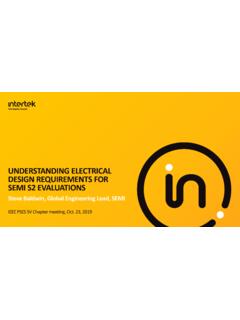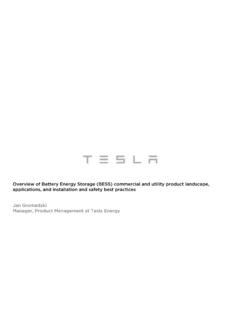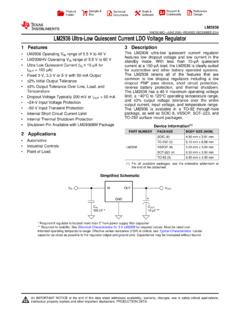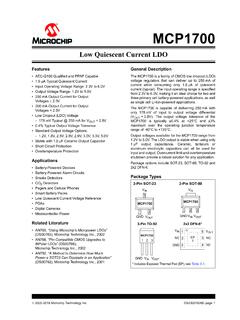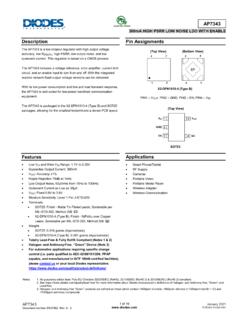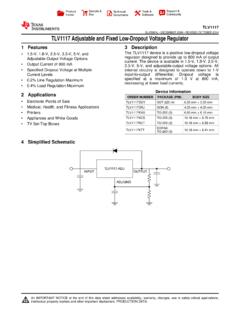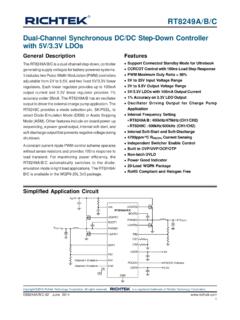Transcription of Low Drop-Out (LDO) Linear Regulators: Design ...
1 1 IEEE Santa Clara Valley (SCV)Solid State Circuits SocietyFebruary 11, 2110 Edgar S nchez-SinencioTI J. Kilby Chair ProfessorAnalog and Mixed-Signal Center, Texas A&M UniversityLow Drop-Out (LDO) Linear regulators : Design Considerations and Trends for High Power-Supply Rejection (PSR)Power Management Why do we need power management? Batteries discharge almost linearly with time. To optimize the charging of batteries to be safe and extend their life. Circuits with reduced power supply that are time dependent operate poorly.
2 Optimal circuit performance can not be obtained. Mobile applications impose saving power as much as possible. Thus, the sleep mode and full power mode must be carefully controlled. Objective of a power converter is to provide a regulated output voltageVoltageBattery ( Li-ion)Regulated VoltageTime23 What are the conventional power converters? Low drop out Linear regulator (LDO) Switch inductor regulator (switching regulators ) Switch capacitor regulator (charge pump)Why do we need different Power Converters Types?
3 Different applications Desired efficiency and output rippleWhat is the purpose of combining several converters?CPLDOB attery+-VREGULATEDLDOCPB attery+-VREGULATEDSRLDOB attery+-VREGULATEDCan we combine them? Linear Regulator: Basic IdeaThus in order to keep constant Vo, the value of the controlling resistorRC yields:So RCshould be controlled such that Vo= Vdesired, reg voltageVBATRCRLOADVO+- = = =OLDOLOADOOBATLOADOBATLOADCVVRVVVRVVRR1 Vomust be constant and VBAT is changing as a function of timeBATCLOADLOADOVRRRV+=LOADCRR<<Feedbac kControlRLOADRCVCVBATVO+-4 RloadControl CircuitEAVoutVinIinIoutLDO The LDO act as a variable resistor that is placed between input power source and the load in order to drop and control the voltage applied to the load.
4 Compared to DC DC switching regulators , LDOs are: Of continuous operation Easier to use Cheaper solution But of Lower efficiencyLow Dropout Voltage Regulator (LDO)INLDOININOUTININLOADOUTINOUTVVVVVIV IVPP =<= BATLDOVV 1 The output error voltage (EVO) is defined as: OR%100 + LOADCCVORRRE%100 = MAXOUTLOADOUTMAXOUTVOVVVE RC5 Implementing RCand the Feedback ControlababVC = VGSNMOS Pass TransistorILOADVDO = ILOADRCabVC = -VGS = VSGPMOS Pass TransistorVDO,n= VSAT+VgsVDO,p= VSD(SAT)VGSE rror AmplifierVC,PMOSR1R2 VREFVOE rror AmplifierVC,NMOSR1R2 VREFVO For an ideal op amp gain, the differential input is zero, VREF is a Bandgap voltage which is also supplied by VBAT= +REFOVRRRVREFOREGUTOVRRVVV +===211OR67 Let us analyze the basic LDO architecture.
5 First, we will consider ideal components, then the non idealities are introduced together with the accompanied Design challenges to tackle. BG is the band gap reference AnalysisVIN =VBATB asic LDO TopologyREFEAmEAmDIVmopINLopOVAgAgRVgrVR RrV= + + ++1111111 Small Signal Representation011121= +RVRRVODIV(1)(2)VoVINAEA( VDIV -VREF)VXVDIVR2R1ropRLgm( Vx ViN)VINE rror AmplifierBGPMOS Pass TransistorR1R2 IoLoad (RL)AEAVDIV8]1[)1(LopEAPTEAPTREFPTinoRrA AAAVAVV++++= Where: LopmPTRRRRRRrgA>>++==)( and ,)/( ,21212 Thus Vocan be expressed as:)1()1(EAPTEAPTREFEAPTPTinoAAAAVAAAVV +++=If EAPTAAT=Vo yields.
6 1()1(/TTVTATVVREFEAino+++ T is the open loop gain. Furthermore for T >>1 REFEAinoVAVV+ Observe that Vinis attenuated by AEAand Vrefis not. Solving the (1) and (2), Vo becomes:9 EAPTPTEAPTPTinoRAAAAAAVVL +=+= =1)1(EAinoRAVVL 1 =refV + ++= inosREFEAinoVVVRRAVV2111 osV The line regulation is a steady-state specification. It can be defined as:For a practical case with non-idealities such as offset Op-Amp voltage and reference voltage error ; the line regulator becomes:Observe that designers should also minimize: and provide Vrefto be independent of VBATand temperature and process RegulationosV Pass transistor load current will determine its size and thus layout Error amplifier The accuracy required by the LDO, determines the magnitude of the open loop gain.)
7 Single pole architectures are recommended for better and easier stability. The amp transient requirement is dependent on the stability gain and phase margins. There is a trade off in making the PM high and speed of amp. This is also true for the Gain. Should have high PSRR Bandgap voltage reference Should have high PSR Stability and speed of the feedback loop Should be assured under all load conditions Choice of the capacitors and feedback resistors (Rf1and Rf2)Issues of Concern in LDO DesignError AmplifierMp: PMOS Pass TransistorRf1Rf2 IoLoad (RL)AError_AmpVDIVVIN = VBATCLVREFVoutZLBandgap10 NMOS pass FET is easier to compensate at low loads and dropout, due to the higher output impedance of PMOS.
8 NMOS pass FET are smaller due to weaker drive of PMOS. NMOS pass FET LDO requires the VDD rail to be higher than Vin, while a PMOS does not. To do this, a charge pump is usually required with accompanying disadvantages of higher quiescent current and extra charge pump noise. Power Supply Rejection (PSR) is better with PMOSNMOS vs. PMOS Pass Transistor11 Dropout voltage (Vdo):This is the difference between the minimum voltage the input DC supply can attain and the regulated output voltage. Input rail range:This is the input supply voltage range that can be regulated.
9 Lower limit is dependent on the dropout voltage and upper limit depends on the process capability. Output regulated voltage range: This is the output voltage variation the regulator guarantees. When output voltage is in this range, it is said to be in Significant Parameters 1 VoutVinInput rail rangeOutput regulated range~1 YXDropout voltage = X - Y12 Output current range: This is the output current handling capability of the regulated output voltage. Minimum current limit is mainly dependent on the stability requirements Maximum current limit is dependent on Safe Operating Area (SOA) of pass FET and also maintaining output voltage in regulation.
10 Load regulation: This is the variation in output voltage as current moves from min. to max. Line regulation: This is the variation in output voltage as supply voltage is varied from min. to Load/Line transient regulation: This is a measure of the response speed of the regulator when subjected to a fast load/Vsupply Significant Parameters 1IL_maxIL_minILVoutttVin_maxVinVoutVin_m inttLoad transient regulationLine transient regulation13 PSR: Power Supply Rejection (or ripple rejection) is a measure of the ac coupling between the input supply voltage on the output voltage.
